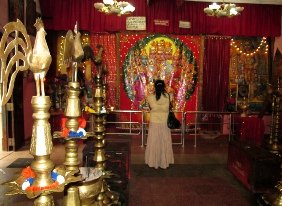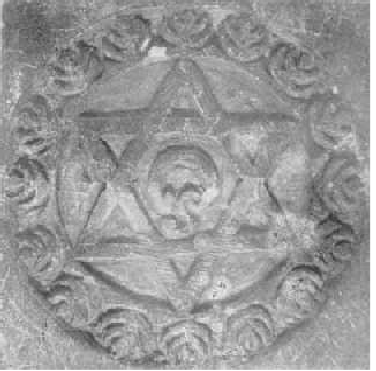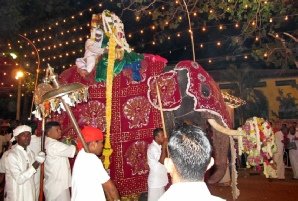© 2023 Dr Margaret Sheppard
Main Kataragama Temple



Inside the main Temple dedicated to Kataragama. The walls are adorned with his images. This one relates the legend that he was formed from the spark from Shiva his father’s eye, that fell into the Ganges and turned into six children, who in turn became fused into one Deity -
The Sacred Yantra design -
The Yantra is kept in the “holy of holies” and carried in its casket on the back of the Chief Elephant at Perahera.
(This above representation is from Paul Wirz’s photograph reproduced in Wikipedia)

The first Temple for Kataragama was allegedly built in gratitude during the first century B.C., by Dutugemunu, the king of the Singhalese. A Tamil King called Elala had conquered much of the Singhalese kingdom and Dutugemunu struggled to reconquer his lands. Then his father appeared to him in a dream in which his father advised him he must first obtain the approval of Skanda (Kataragama).
Dutugemunu then went on a pilgrimage and underwent penitence and prayed to the Deity who heard his prayers and agreed to help him to victory with the weapons he gave to the king. Dutugemunu then with this help from the Deity defeated Elala. Thus he built a temple for him at Kataragama to fulfil the vow he had made when he asked for the Deity’s assistance. Those kings following Dutugemunu continued to support and add to the temple complex and Kataragama was greatly venerated by them. (In fact before the Kandy Perahera became a Buddhist ceremony in honour of the very sacred tooth of Lord Buddha, it was a Hindu ceremony venerating Kataragama and two other Deities.)



Ancient statue of King Dutugemunu situated by the main Buddhist Temple. Pilgrims leave offerings such as scented flower petals and money inside the new protective glass pavilion
Offerings of oil to enable the lamps to burn eternally are poured inside the adjoining glass covered structure



At the annual Esala Perahera, the sacred relic is carried reverently on the back of the main elephant at the climax of the procession. The Chief Shrine Guardian rides with it on the elephant and the assistants surround it. The relic box is reputed to contain the sacred Yantra engraved on gold leaf and/or the minature golden statue of Kataragama (or a replica!) The elephant is magnificently decorated and carries a beautiful garland of flowers on his tusks. As he passes along the processional route in front of the Temple entrance, the devotees throw sweet smelling flowers onto him and spray expensive perfumes. He is a senior and very well behaved elephant who is well used to his public appearances and trusted with this important, sacred task. (Younger, inexperienced elephants in the procession sometimes run amok, thus strong barriers are erected along the processional route to protect the thousands of on-
Kataragama is a Deity whom many fear and is believed to demand penitential vows from humans in exchange for his assistance. Pilgrims and supplicants thus can be seen fulfilling their vows by e.g. walking on fire, walking on nails or being suspended by hooks pierced through their skin.
One unusual aspect about Kataragama Temple is that in the “holy of holies” (the inner room of the main shrine screened from public view by seven curtains) there is no statue of Kataragama. However there is believed to be a sacred Yantra engraved on gold leaf. It is this that is allegedly in the cabinet that is carried on the back of the chief temple elephant at the conclusion of the Perahera procession. Others claim there is in fact a 2 cm high golden statue of the Deity kept in a special box, but it is NEVER taken out of the Shrine and only the main priest is ever allowed to see it. Again others claim that this sacred statue is on the back of the elephant at Perahera but others claim this is only a replica of the real one that is always kept well inside the Shrine.
Beside the Maha-
The main Temple, the Maha-
The Valli-
Near this temple to Valli-
The Ganesh temple is supposedly built on the site where Kataragma and Valli-
The main Buddhist Temple is along a tree-
In nearby Sella-
Seven holy mountains surround this sacred place, seven little streams have their source here and legend tells that they were created by Kataragama himself with the purpose of preventing Valli-
Three Peraheras are held at Kataragma. The largest is the Esala (July) Perahera which lasts for 14 days from the July New Moon (on which the wedding of Kataragama to Valli-
There is a smaller 3 day Perahera in November and a further Perahera is celebrated in April for the Buddhist and Hindu New Year.
For much fuller details about this interesting and sacred site see the Kataragama website: kataragama.org. This site has a wealth of information about this interesting site and includes a plan of the site and surrounding area’s other religious sites.)
Also see videos on Premlanka Hotel You Tube channel that show excerpts of dances performed during the Kataragama Perahera.